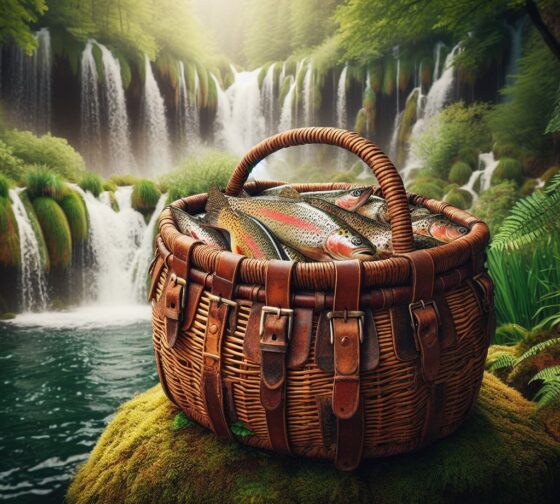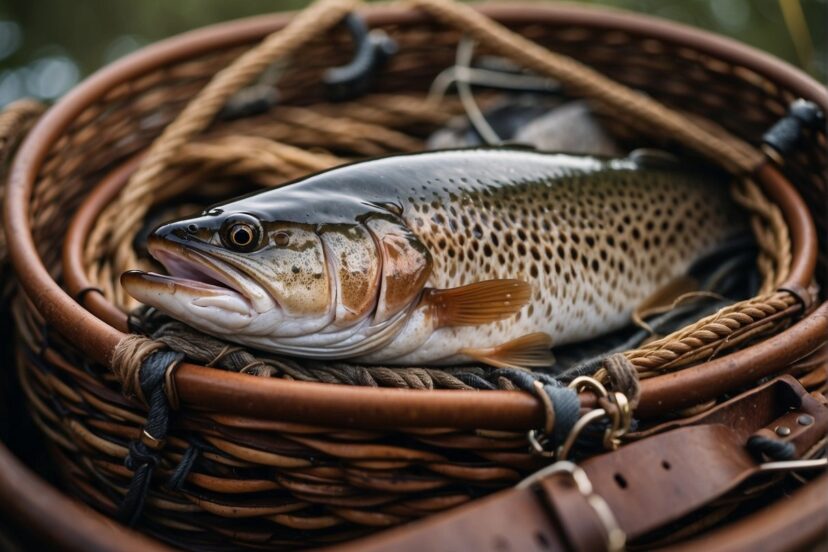Fishing Creel: Tales from the Angler’s Basket
*We may earn a commission for purchases made using our links. Please see our disclosure to learn more.
Fishing Creel Essentials: Choosing the Right One for Your Angling Adventures
As an angler, I appreciate the importance of having the right equipment for a successful fishing trip, and a fishing creel is an essential tool for any fisherman. A fishing creel is a container used to hold fish after they have been caught, serving not only as a means of storage but also as a way to keep the catch fresh until I can return home. Throughout history, the creel has been an integral part of the angler’s gear, often reflecting regional designs and fishing traditions.
Various materials are used to construct creels, with traditional options including wicker and canvas, and modern designs featuring neoprene and other durable synthetics. Wicker creels, for example, are known for their classic aesthetic and naturally cool interior, which is ideal for keeping fish in good condition. I’ve noticed that with innovation, creels have evolved to cater to different fishing environments and preferences, encouraging an angler like me to choose based on what suits my particular style of fishing.
Selecting the right creel involves considering the type of fishing I’m engaging in, whether it’s fly fishing, which might call for a lightweight and compact creel, or larger game fishing, necessitating a more robust and spacious option. Creels are designed with various carrying styles including shoulder straps and backpack forms to cater to comfort during long hours by the water. It is clear that whether my preference is for a creel that reflects a touch of tradition or the latest in angling gear technology, there is a vast array of creels to suit the needs of any serious angler.
History of Fishing Creels

Fishing creels, integral to traditional angling, have a rich history dating back centuries. Crafted to carry the day’s catch, they reflect both the practical needs and the artistic craftsmanship of their time.
Early Designs and Materials
My exploration into the origins of fishing creels reveals that wicker and willow have been the materials of choice since the inception. The earliest creels I’ve come across were not only utilitarian but also displayed a level of craftsmanship that classified them as artisanal objects. Wickerwork, known for its durability and lightweight properties, made these baskets ideal for carrying fish like trout. An antique wicker trout creel from the 1600s signifies how ingrained these tools were in the angling practices of the time. Due to their age, these articles are now considered highly collectible.
- Materials Used:
- Wicker
- Willow
- Leather
Evolution of the Fishing Creel
As I move forward through history, I observe that the design of fishing creels evolved, with improvements tailored to the needs of anglers. The addition of leather straps for comfort and the inclusion of compartments for tackle and bait demonstrate an ingenuity in design. During the 20th century, manufacturers began to explore other materials like canvas and synthetic fabrics, though traditional creels made of wicker or willow remained popular for their aesthetic appeal. Vintage and antique creels, particularly those from before and after World War II, became sought-after items, valued as much for their history as for their utility.
- Key Developments:
- Addition of leather straps
- Introduction of compartments
- Use of new materials (post-1900s)
Types of a Fishing Creel

In my experience, selecting the right fishing creel is paramount for any angler looking to efficiently carry their catch. Different materials and construction affect their durability and suitability for various fishing conditions. Let’s examine some of the common types available.
Wicker Creels
Wicker fishing creels are the quintessence of the angling tradition, renowned for their classic aesthetic. Typically made from willow or other light woods, they offer exceptional ventilation which helps to keep the catch cool. The design of wicker creels has proven timelessly effective, allowing water to escape while securely holding fish.
Canvas Creels
When it comes to durability, canvas creels stand out. They are constructed with a robust fabric that can endure the rigors of frequent use. Although less traditional than wicker, canvas creels are often equipped with additional pockets and compartments, providing convenient storage for tackle and other fishing essentials like reels and lines.
Wooden Creels
Crafted for ardent enthusiasts, wooden creels denote a touch of nostalgia. These baskets are sturdy and have a distinct artisanal appeal. However, they can be quite heavy compared to other types, and their solid construction lacks the airflow found in a wicker creel, which makes it crucial to promptly clean them to prevent odors.
Modern Creels
Modern advancements have introduced modern creels that often incorporate synthetic materials, making them lightweight and more ingress-protected. Features like built-in coolers facilitate the maintenance of an optimum temperature for the catch. Brands like Eagle Claw offer some of the best fishing creels with contemporary features for today’s anglers.
Choosing the Right Fishing Creel

To ensure an effective and comfortable fishing experience, I focus on the specific characteristics of a creel. I prioritize size, material, and additional features to meet my needs.
Size and Capacity
The dimensions of the creel are critical for meeting my fishing requirements. I look for a size that comfortably holds the type of fish I target. For example, a creel 14″ x 9″ will usually accommodate about half a dozen fish up to 14 inches in length. I make sure the creel is neither too large to carry comfortably nor too small to store my catch.
Ideal Creel Sizes:
- Small Creeel: Suitable for fewer or smaller fish
- Medium Creel (14″ x 9″): Fits half a dozen medium-sized fish
- Large Creel: Optimal for larger catches or longer fishing sessions
Material and Durability
The construction material of the creel affects both its durability and functionality. I often choose creels with a vinyl construction for its water resistance and ease of maintenance. For a balance of tradition and durability, a wicker creel with leather trimmings provides breathability for the catch with a robust exterior. The stress points should be reinforced, particularly if they feature buckles or snaps, to ensure longevity.
Materials to consider:
- Vinyl: Lightweight and water resistant
- Wicker and Leather: Breathable and sturdy
- Ensure durability at stress points including:
- Leather straps
- Buckles and snaps
Additional Features
My creel should offer more than just carrying space—it should have practicality woven into its design. I consider pockets and compartments essential for organizing gear such as hooks, weights, and line. These often come with zippers or snaps for secure closure. A comfortable leather strap is a must for ease of transport.
Features I look for:
- Compartments: For organized storage
- Secure Closures: Zippers or snaps on pockets
- Comfort: Padded or leather straps for carrying
Care and Maintenance of Your Fishing Creel

In ensuring the longevity of a fishing creel, I focus on effective cleaning, proper storage, and timely repairs. These practices not only maintain the creel’s functionality but also enhance its durability.
Cleaning and Storage
For clean-up, I make sure to empty the creel of all debris and rinse it with fresh water. If it’s a wicker creel, I use oxygen bleach and a cotton cloth for interior cleaning, since it’s safe and won’t damage the wicker. For creels with vinyl components, mild soap and water suffice. I then leave the creel open to air-dry completely.
Storage is just as crucial as cleaning. I keep my creel in a cool, dry environment to prevent mold and mildew. When storing, I avoid stacking items on top of the creel to prevent distortion of its shape.
Repairs and Restoration
When I come across damage or wear, prompt repairs ensure continued use. For leather closures, I condition the leather to prevent drying and cracking. If the leather breaks or wears out, I replace it with a new piece.
Restoration often involves tightening loose wicker. Submerging the wicker in water for a limited time can tighten it, but it’s a method I use sparingly to prevent over-soaking, which might weaken the strands. After wetting, the creel should be carefully reshaped and allowed to dry slowly.
By following these specific care and maintenance strategies, I keep my fishing creel in prime condition for every fishing expedition.
Using Your Fishing Creel
In this section, I will guide you through preparing your fishing creel for a trip and the appropriate usage once you’re out on the water. From what to pack to how to carry your catch with respect to fishing etiquette, my goal is to ensure you have a seamless experience.
Packing for a Fishing Trip
When planning for my fishing trip, I always start by selecting the right fishing basket. The creel is more than just a container; it’s integral for storing and transporting the day’s catch. Here’s a checklist of what I pack:
- Essentials: License, bait, extra line
- Tackle: Variety of hooks, sinkers, bobbers
- Personal items: Sunscreen, insect repellent, snacks
- Creel maintenance items: Clean cloth, small water container for rinsing
For trout fishing, specifically, I ensure my basket is large enough to accommodate my expected catch, keeping in mind the season’s limits and the sizes I’m aiming to reel in.
Proper Use and Etiquette
Once I’m at my chosen fishing spot, I use my creel thoughtfully:
- Tight Lines: I wait until I have a firm catch before preparing the creel.
- Catch Handling: I handle the fish gently and transfer it quickly into the creel.
- Creel Positioning: I keep the creel partially submerged or in the shade to keep it cool.
- Respect Limits: I adhere strictly to catch limits, ensuring I only store what’s permitted.
By following these steps, I show respect to both the environment and fellow anglers, making sure the experience remains enjoyable for everyone.
Where to Buy a Fishing Creel

When looking for a fishing creel, I consider both local retailers and online marketplaces to find a product that meets my specific needs. There are options available for both standard and custom, handmade creels, depending on what I’m looking for.
Local Stores vs Online
Local Stores
At local outdoor stores like Cabela’s or Bass Pro Shops, I usually find a limited selection of fishing creels, with the possibility of seeing the product before purchasing. These stores often feature brands like Flambeau and Eagle Claw which are known for their practicality and durability. I always check for customer reviews, which local stores have on display or are available through their respective websites.
Online Marketplaces
In contrast, online platforms like Amazon and Scheels offer a wider range of fishing creels from various manufacturers including Berkley. I find detailed descriptions, reviews, and the convenience of home delivery. However, it’s important for me to verify seller ratings and return policies, especially when buying high-quality items such as Schnell or Nelson creels which can be considered rare finds.
Custom and Handmade Creels
Custom Creels
For a personalized touch, I look for artisans who craft custom creels. Sites like Etsy host a variety of creators such as Lawrence and Clark, who may offer to include engraved nameplates or choice of materials. They provide a unique opportunity to own a creel that’s personalized for me or as a thoughtful gift for a fellow angler at my camp or lake.
Handmade Creels
Handmade creels by local craftsmen or small businesses can often be discovered at fishing expos or markets. McMonies and Peters are examples of such artisans known for their craftsmanship. The benefit of buying directly from them is the chance to discuss custom features and support local artisans while purchasing a product that genuinely stands out in both beauty and functionality.
FAQs About Your Fishing Creel
In this section, I cover some of the most common inquiries about fishing creels, helping you to select and maintain the right option for your fishing adventures.
1. How do you choose the best fishing creel for your needs?
To find the best fishing creel, consider the type of fishing you do, the size of your catches, and the materials you prefer. Durability, portability, and ease of access are key factors. For instance, a vinyl creel with a comfy strap may be ideal for longer fishing sessions.
2. What are the differences between a wicker fishing creel and a bag-style creel?
Wicker fishing creels are traditional, offer natural ventilation, and are aesthetically pleasing. They’re typically stiffer and can stand upright. Bag-style creels, often made of vinyl, are more lightweight and sometimes have features like insulation to keep catches cool.
3. What maintenance is required to preserve an antique fishing creel?
Maintaining an antique fishing creel involves keeping it dry and clean after use to prevent mold and mildew. Regular dusting and a gentle wash with water and mild soap can keep it in good condition. Avoid harsh chemicals that can damage the wicker.
4. Can you explain the advantages of using a fly fishing creel?
A fly fishing creel is usually compact and convenient, designed to be unobtrusive while wading in the water. It often comes with added compartments for tackle and provides enough space for the typically smaller catches of a fly fisherman.
5. What should you look for in terms of quality when selecting a fishing creel basket?
When selecting a fishing creel basket, check for tightly woven wicker or strong seams in fabric creels to ensure long-term durability. The lid, straps, and fastening mechanisms should be well-constructed and should function properly to safely secure your catch.




